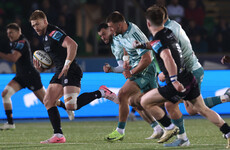LET’S REWIND to April 2020.
This was when Ireland’s attack was still seen as being predictable. The perception among opposition teams was that if you could shut down Johnny Sexton, you could shut down Ireland. England out-half George Ford summed it up:
“There’s teams that are very dominant who play off 10,” said Ford on The Magic Academy podcast.
“A team like Ireland is ‘Where’s Sexton? Where’s Sexton?’ Wherever Sexton is, is where the ball is going.
“I suppose from an attack point of view, it’s interesting that you don’t want to probably be as predictable as that in terms of… you want to have the ability to go either side or either way with different options.”
Andy Farrell and his attack coach, Mike Catt, understood this issue when they came into the job after the 2019 World Cup and they have set out to make Ireland an unpredictable attacking team.
There have been teething issues and Ireland’s attack has been poor at times in the last two years. This author was among those to question the Irish attack, but it has flourished in their last three major games against England, Japan, and New Zealand.
The hard work being done behind the scenes is beginning to pay off and Ireland’s attack is now more unpredictable. While Sexton is still the main man, the captain, and the driving force in so many ways, this Irish attack is becoming less reliant on him.
Farrell’s belief is that rugby is, first and foremost, a decision-making game. He wants every single player in his team to be confident enough and skillful enough to be able to make decisions on the ball, meaning that defences constantly have to worry about multiple threats.
Every single starting Irish player in yesterday’s 29-20 win over the All Blacks made more than one pass in the game, with the recent trend of forwards using their handling skills continuing in prominent style. Ireland made a collective 212 passes yesterday, following 215 against Japan.
With Catt having brought in a 1-3-2-2 attack shape, Ireland are now posing demanding questions to defences and the All Blacks struggled in at times yesterday.
Ireland made an impression from early in the game, with their first attacking momentum sparked by fullback Hugo Keenan stepping up as a playmaker.
We can see that Sexton is positioned in the shortside as we join play in the second minute.
Out on the left of the ruck, Keenan has set up as the ‘release’ player out the back of a pod of three forwards [yellow below], providing Andrew Porter with an option to pass out the back.
It’s important to have players positioned in this slot out the back of the forward pods, ensuring the defence has several threats to worry about – a carry, a tip-on pass, or a pass out the back door.
Porter carries in this instance and on the next phase, we can see that Keenan has a pod of two forwards [blue below] to his left, with Bundee Aki set up out the back of that pod.
Again, the All Blacks have multiple options to worry about and Keenan makes a decision to carry himself – identifying tighthead prop Nepo Laulala in front of him, dummying, and darting through the defence.
Iain Henderson carries around the corner on the next phase and then Ireland shift the ball fluidly from left to right to get outside the Kiwis.
Below, we can see the attacking shape Ireland’s forwards have snapped into, with a 3-pod off the breakdown [yellow], a 2-pod in midfield [blue], and Jack Conan [black] holding as the wide forward.
Sexton is loaded in behind the 3-pod but it’s interesting to note how Aki, Keenan and Ringrose [pink below] haven’t set up in any obvious slots at this early stage.
This makes it harder for the All Blacks to predict Ireland’s intentions on this phase.
Again, the variety of options is key here. In the 3-pod off the ruck, Caelan Doris can carry himself, tip on a short pass to Tadhg Furlong – who runs a convincing, well-timed line on his right – or go out the back to Sexton.
Just note below how Furlong’s run lures Ardie Savea onto him. Ireland have run these lines superbly in the past fortnight, with Catt deserving great credit for the improvement in this area of their game.
Against Japan, Sexton made a half-break and offload from a very similar play in which Furlong passed to him but his decision is different on this occasion.
Again, the genuine running lines of Andrew Porter and James Ryan as the 2-pod are important after Sexton receives the ball from Doris. They’re a viable carrying threat off Sexton and, as a result, they sit down two defenders.
But Sexton plays out the back as Aki, Keenan, and Ringrose have been in motion, bouncing out behind this 2-pod at a late stage.
Aki skips Keenan to Ringrose and he sends Conan into space, with the number eight moving the ball on to Conway and the wing carries up to the New Zealand 22.
As Ireland play off the right touchline, it’s left wing James Lowe who pops up as first receiver.
Farrell and Catt have encouraged their wide men to get off their wings as much as possible in order to keep changing the pictures for defences, and Lowe works hard across the pitch in this case, starting on the left…
And tracking play across to the right…
One thing Ireland need to be cognisant of is ensuring they still maintain good width as their wings go roaming. While their 1-3-2-2 shape caters for this by holding at least one forward out in the 15-metre channels, there were a handful of occasions when they were left narrow in attack against the All Blacks.
On the next phase after Conway’s carry, Lowe acts as a link to the 3-pod of forwards, with Sexton out the back to move the ball on to Furlong in the 2-pod.
This attack fizzles out on the next phase in what is an example of how Ireland are still a work in progress.
Sexton doesn’t actually want the ball to the left of the ruck, pointing instead to his right.
We can see that Ireland have four attackers in the shortside in Keenan, Ringrose, Conan, and Conway [pink below]. Lowe, meanwhile, has tracked across with Sexton.
This probably needed one of Lowe or Keenan to step up as first receiver on the right and demand the ball from Gibson-Park.
Instead, the scrum-half passes to Sexton with very little on out on the left where van der Flier is holding some width but Ireland are short on bodies. Sexton carries but Ireland give up a side entry penalty at the breakdown and the promising attack ends.
Nonetheless, it was a warning shot and Farrell’s men continued to grow as an attacking force as the game went on.
The example below comes with Sexton down on the ground after the high tackle that saw Codie Taylor sin-binned. Again, it’s encouraging for Ireland that their attack flowed even without the great out-half involved initially.
Ireland have played off a left-hand-side lineout and as they bounce back to their left through Furlong at the heart of a 3-pod [yellow above], Ringrose is set up out the back.
Hooker Rónan Kelleher holds width, while the trio of Aki, Keenan, and Lowe again swing late into position, giving the All Blacks defenders no real early cues.
The passes from Gibson-Park and Furlong aren’t their best but they find Ringrose, who is presented with TJ Perenara shooting up on the edge of the All Blacks’ defence – worried by Aki, Keena, and Lowe showing their hand at a late stage.
Ringrose makes a good decision to throw the bridge pass over Perenara’s head and Kelleher has time and space to sit Beauden Barrett down on his way up to the halfway line.
On the next phase, Sexton is back on his feet and acts as the first receiver, making a good decision to pass to Henderson at the edge of the 3-pod – again delivering a different option within Ireland’s attack shape.
Sexton is late-tackled on the next phase just after kicking diagonally for Conway to chase, meaning Ireland get a penalty, while TMO Tom Foley also notifies referee Luke Pearce of the need to look at Taylor’s earlier high tackle.
Later in the first half, Sexton was down injured and Ireland again showed that they can go forward without him directing play.
First, Ringrose darts from the first receiver position.
As Ringrose carries, we can see Lowe working off his left wing again…
And then bursting onto a pass from Gibson-Park to the right of the ruck to change the picture for the defence at a late stage, dummying a return pass to his scrum-half, then offloading to Doris on his right.
Lowe carries on the very next phase again, working hard to get over the gainline for the second time.
And then on the next phase, we can see that Aki has helped to organise a little bit of shape as he slots in behind a 2-pod [blue below] made up of Henderson and Conan.
Gibson-Park makes a good decision to hit Conan, the wider of the two forwards, and he links out the back to Aki, allowing Ireland to make further progress up the right.
Unfortunately for Ireland, this was one of the many 22 visits they couldn’t turn into points as Doris lost control of the ball in contact just five metres out a couple of phases later.
This was one of the areas that will have disappointed Farrell and co. yesterday. Ireland had 16 visits into the New Zealand 22 and left empty-handed on 12 occasions. Had they been able to convert a few more of those opportunities, particularly in the first half, the scoreline might have had a very different look to it.
While a couple of decisions went against Ireland in this area of the pitch, they will certainly be working hard on their close-range game, looking to add more variety to their attacking palate when they’re near the tryline.
Sexton was forced off with a head injury in the 65th minute of this game but that didn’t mean that Ireland’s fluidity and threat in attack further out the pitch came to an end.
Indeed, they continued to drive at the All Blacks as they looked to close out the game and we saw another excellent passage of attack in the 71st minute.
With replacement out-half Joey Carbery part of the breakdown, Ireland play to a 3-pod on the right of the breakdown below and Ringrose is positioned out the back.
While Ryan decides to carry the ball himself here, Ringrose shows good animation – calling for the ball with his hands up – in order to draw defenders’ eyes onto him.
This kind of work often helps to reduce defensive linespeed or forces errors from defenders who have several options to worry about.
On the next phase, Ringrose is the first receiver, with a 2-pod outside him [yellow below], Lowe swinging out behind them at a late stage, and Conan holding width.
Ringrose splits the pod and passes to Lowe, who in turn finds Conan running an excellent line in between two All Blacks defenders.
Note Aki’s role in opening up the space here. All Blacks centre David Havili shoots up onto Lowe [white below], while left wing Sevu reads out the back of Conan onto Aki.
Lowe and Aki’s work helps to open up the space for Conan to pick an excellent line, while we can also see Conway at the bottom of the shot above holding width.
Conan surges all the way up to the All Blacks’ 22 but is then stripped of the ball after his knee has hit the ground, meaning it really should have been a penalty to Ireland.
For Farrell and Catt, it’s very encouraging to see the likes of Ringrose, Aki, Lowe, and Keenan helping to organise the attack and making good decisions on and off the ball.
Gibson-Park’s decision-making has been good for Ireland in recent times too, again taking some burden off Sexton’s shoulders and helping to make the Irish attack more unpredictable.
This pass to create a try-scoring opportunity in the first half is a prime example.
We can see that Sexton presents as the first receiver but just watch Gibson-Park’s head movement above as he scans the defence and picks out a better option.
His decision is to skip Sexton to Conan, allowing the number eight to surge into space on the outside shoulder of Ethan Blackadder. It’s a very similar pass to the one Gibson-Park threw for Lowe’s try against Japan last weekend.
Again, it’s not the play that the All Blacks foresaw and it nearly produces a score as Conan offloads back inside to Gibson-Park only for New Zealand captain Sam Whitelock to knock the ball loose in a try-saving tackle.
While Ireland didn’t get direct reward for their excellent attack in the instances we’ve looked at here, the combined effect of their relentless movement of the ball and ceaseless attacking focus – the All Blacks had to make a whopping 231 tackles in this game – was the three tries they did score in racking up 29 points.
Normally, the All Blacks are the team who make defences uncomfortable with their varied, high-tempo attack. That scenario was flipped on its head yesterday.
With Farrell and Catt prompting playmaking growth from their entire backline, as well as encouraging their forwards to use their handling skills, these are exciting times for the Irish attack.
Sexton is very much still the main man in this squad and his influence remains pivotal. There were many examples of his playmaking qualities in this game, but there were also signs that Ireland’s attack is becoming less reliant on him and more unpredictable as a result.










































Been waiting for this article all day. Few beers in front of the fire to read this later
Playing more heads up rugby since Stander left
@Tom Cunningham: oh Jesus!!
@Tom Cunningham: ‘Andy Farrell’s Ireland touch the sky after All Blacks win but ultimate vindication must wait’ – https://www.bbc.com/sport/rugby-union/59278344 PLEASE read , you will learn
@Michael Murray: ….this article sums up transition from Joe to Andy perfectly. It really is a must read and so many of the posts on this site over the last 2 years could have done with having read it.
Insightful as ever.
How can teams organise to defend against this sort of attacking variation?
Again the most over rated team in World Rugby
@Tony Mcgrath: that’s harsh in New Zealand Tony. They are the best team in the world at the moment, even if SA are the reigning world champions.
That Ringrose pass was super tidy.